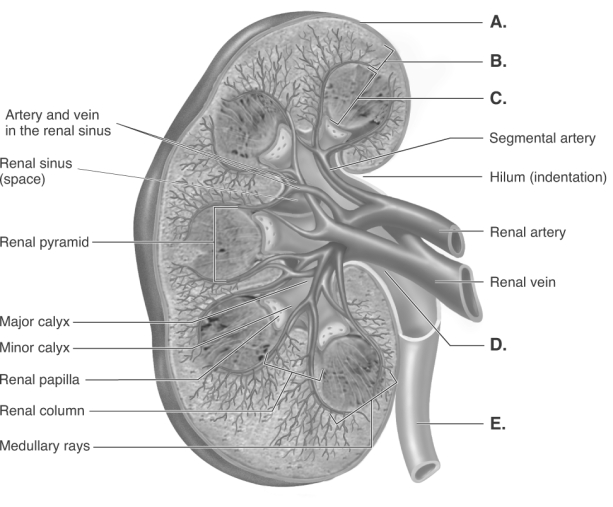A) water can easily enter or leave.
B) potassium and chloride are cotransported with sodium across the apical membrane.
C) calcium ions are actively transported across the basal membrane.
D) potassium is concentrated in the filtrate.
E) the filtrate does not change.
Correct Answer

verified
Correct Answer
verified
Multiple Choice
Which of the following statements is true?
A) Only sodium diffuses from the descending limb.
B) Solutes are actively transported from the ascending limb.
C) Na+ and Cl- ions are actively transported into the vasa recta.
D) The osmolality of the descending limb decreases as filtrate moves through.
E) Water moves by osmosis out of the ascending loop.
Correct Answer

verified
Correct Answer
verified
Multiple Choice
Match the term with the appropriate definition. -urine
A) amount of blood flowing through kidneys per minute
B) amount of plasma filtered through filtration membrane
C) movement of plasma across filtration membrane
D) movement of substances from filtrate back into blood
E) non-reabsorbed filtrate
Correct Answer

verified
Correct Answer
verified
Multiple Choice
What part of the urinary bladder expands very little during bladder filling?
A) the fundus
B) the trigone
C) the neck
D) transitional epithelium
Correct Answer

verified
Correct Answer
verified
Multiple Choice
 -The diagram is a sagittal section of the kidney. What does "E" represent?
-The diagram is a sagittal section of the kidney. What does "E" represent?
A) renal pelvis
B) medulla
C) cortex
D) renal capsule
E) ureter
Correct Answer

verified
Correct Answer
verified
Multiple Choice
Trace the path of a red blood cell from the renal artery to the glomerulus: (1) interlobar artery (2) interlobular artery (3) segmental artery (4) arcuate artery (5) afferent arteriole
A) 1, 2, 3, 4, 5
B) 1, 4, 2, 3, 5
C) 3, 1, 2, 4, 5
D) 2, 1, 3, 5, 4
E) 1, 4, 3, 2
Correct Answer

verified
Correct Answer
verified
Multiple Choice
The kidney dialysis machine is an example of a mechanical
A) active transport system.
B) countercurrent system.
C) cotransport system.
D) sorting system.
E) toy.
Correct Answer

verified
Correct Answer
verified
Multiple Choice
Cortical tissue located between the pyramids is called the
A) calyx tissue.
B) renal papillae.
C) renal columns.
D) medullary rays.
E) renal corpuscles.
Correct Answer

verified
Correct Answer
verified
Multiple Choice
The countercurrent multiplier system
A) is found in the collecting duct.
B) is assisted by hormones.
C) has fluid flowing in parallel tubes in opposite directions.
D) maintains the solute concentration of the medullary interstitial fluid.
E) has fluid flowing in parallel tubes in opposite directions and maintains the solute concentration of the medullary interstitial fluid.
Correct Answer

verified
Correct Answer
verified
Multiple Choice
 -The diagram is a sagittal section of the kidney. What does "D" represent?
-The diagram is a sagittal section of the kidney. What does "D" represent?
A) renal pelvis
B) medulla
C) cortex
D) renal capsule
E) ureter
Correct Answer

verified
Correct Answer
verified
Multiple Choice
What is the effect of intense sympathetic stimulation on the GFR?
A) GFR increases
B) GFR decreases
C) GFR is not affected
D) GFR increases, then decreases
Correct Answer

verified
Correct Answer
verified
Multiple Choice
When sodium is actively transported from tubular cells to the interstitial fluid,
A) no energy is needed.
B) glucose and amino acids are countertransported at the same time.
C) Na+ concentration gradient is established between the tubule lumen and tubule cell.
D) water is countertransported by carrier molecules.
E) water is secreted.
Correct Answer

verified
Correct Answer
verified
Multiple Choice
Blood loss that occurs during surgery will stimulate cells in the
A) efferent arteriole.
B) wall of the right atrium.
C) proprioceptors.
D) juxtaglomerular apparatus.
E) None of these choices is correct.
Correct Answer

verified
Correct Answer
verified
Multiple Choice
Match the term with the appropriate definition. -filtration fraction
A) amount of blood flowing through kidneys per minute
B) amount of plasma filtered through filtration membrane
C) movement of plasma across filtration membrane
D) movement of substances from filtrate back into blood
E) non-reabsorbed filtrate
Correct Answer

verified
Correct Answer
verified
Multiple Choice
Match the structure with the appropriate description. -filtration slits
A) supplies blood to the glomerulus
B) enlarged proximal end of nephron
C) gaps between the podocyte processes
D) plexus of capillaries around tubules
E) arteries that arch over bases of the pyramids
Correct Answer

verified
Correct Answer
verified
Multiple Choice
Autoregulation in the kidney involves changes in the degree of
A) constriction of afferent arterioles.
B) sympathetic stimulation.
C) aldosterone secretion.
D) ADH secretion.
E) None of these choices is correct.
Correct Answer

verified
Correct Answer
verified
Multiple Choice
Match the hormone with the function. -aldosterone
A) increases water permeability in the distal convoluted tubule and collecting ducts
B) affects Na+ and Cl- transport in the nephron and collecting duct
C) causes production of Angiotensin II
D) acts as a vasoconstrictor and stimulates aldosterone secretion
E) produced by heart, inhibits ADH production, reduces ability of the kidney to concentrate urine
Correct Answer

verified
Correct Answer
verified
Multiple Choice
Match the structure with the appropriate description. -arcuate arteries
A) supplies blood to the glomerulus
B) enlarged proximal end of nephron
C) gaps between the podocyte processes
D) plexus of capillaries around tubules
E) arteries that arch over bases of the pyramids
Correct Answer

verified
Correct Answer
verified
Multiple Choice
Match the organ with the appropriate function. -ureter
A) stores urine until voiding
B) transports urine from kidney to urinary bladder
C) organ that forms urine
D) transports urine from bladder to outside of body
E) basic functional unit of the kidney
Correct Answer

verified
Correct Answer
verified
Multiple Choice
In glomerular nephritis, proteins and white blood cells enter the filtrate resulting in
A) increased reabsorption of water.
B) increased reabsorption of sodium.
C) increased secretion of sodium.
D) increased urine output.
E) decreased urine output.
Correct Answer

verified
Correct Answer
verified
Showing 61 - 80 of 207
Related Exams